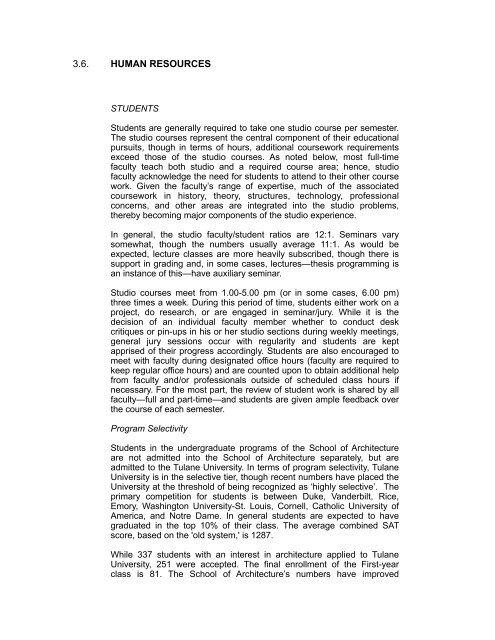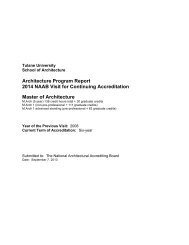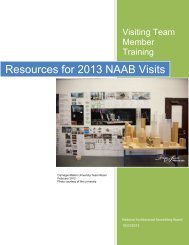Architecture Program Report Tulane University New Orleans ...
Architecture Program Report Tulane University New Orleans ...
Architecture Program Report Tulane University New Orleans ...
Create successful ePaper yourself
Turn your PDF publications into a flip-book with our unique Google optimized e-Paper software.
3.6. HUMAN RESOURCES<br />
STUDENTS<br />
Students are generally required to take one studio course per semester.<br />
The studio courses represent the central component of their educational<br />
pursuits, though in terms of hours, additional coursework requirements<br />
exceed those of the studio courses. As noted below, most full-time<br />
faculty teach both studio and a required course area; hence, studio<br />
faculty acknowledge the need for students to attend to their other course<br />
work. Given the faculty’s range of expertise, much of the associated<br />
coursework in history, theory, structures, technology, professional<br />
concerns, and other areas are integrated into the studio problems,<br />
thereby becoming major components of the studio experience.<br />
In general, the studio faculty/student ratios are 12:1. Seminars vary<br />
somewhat, though the numbers usually average 11:1. As would be<br />
expected, lecture classes are more heavily subscribed, though there is<br />
support in grading and, in some cases, lectures—thesis programming is<br />
an instance of this—have auxiliary seminar.<br />
Studio courses meet from 1.00-5.00 pm (or in some cases, 6.00 pm)<br />
three times a week. During this period of time, students either work on a<br />
project, do research, or are engaged in seminar/jury. While it is the<br />
decision of an individual faculty member whether to conduct desk<br />
critiques or pin-ups in his or her studio sections during weekly meetings,<br />
general jury sessions occur with regularity and students are kept<br />
apprised of their progress accordingly. Students are also encouraged to<br />
meet with faculty during designated office hours (faculty are required to<br />
keep regular office hours) and are counted upon to obtain additional help<br />
from faculty and/or professionals outside of scheduled class hours if<br />
necessary. For the most part, the review of student work is shared by all<br />
faculty—full and part-time—and students are given ample feedback over<br />
the course of each semester.<br />
<strong>Program</strong> Selectivity<br />
Students in the undergraduate programs of the School of <strong>Architecture</strong><br />
are not admitted into the School of <strong>Architecture</strong> separately, but are<br />
admitted to the <strong>Tulane</strong> <strong>University</strong>. In terms of program selectivity, <strong>Tulane</strong><br />
<strong>University</strong> is in the selective tier, though recent numbers have placed the<br />
<strong>University</strong> at the threshold of being recognized as ‘highly selective’. The<br />
primary competition for students is between Duke, Vanderbilt, Rice,<br />
Emory, Washington <strong>University</strong>-St. Louis, Cornell, Catholic <strong>University</strong> of<br />
America, and Notre Dame. In general students are expected to have<br />
graduated in the top 10% of their class. The average combined SAT<br />
score, based on the 'old system,' is 1287.<br />
While 337 students with an interest in architecture applied to <strong>Tulane</strong><br />
<strong>University</strong>, 251 were accepted. The final enrollment of the First-year<br />
class is 81. The School of <strong>Architecture</strong>’s numbers have improved














